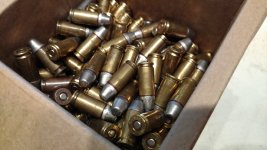Mustang111
Inactive
I am attempting to load a Berry's 124 gr. .356, Hollow base blunt nose using Lee dies in a Rockchucker press. I have sized, primed, expanded, and seated the round. The problem is no matter how deeply I seat the bullet, the case has bulged to the depth to which the round was seated. I have checked to make sure the dies are correct. The sizing and expander dies were screwed in to the shell holder. I set bullets to different depths to check for the depth of the bulge and no matter how deeply the bullet was set, the bulge went to that depth. There was no see for crimp.




